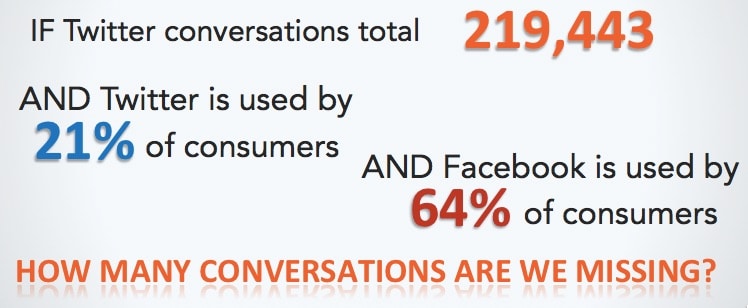Now that Facebook Topic Data is available, social listening platforms can fill the gap we’ve had in analyzing the consumer conversation about our brands we’ve been missing all these years If you weren’t aware, Facebook’s privacy standards make it a closed platform to spiders and indexing. Conversations on individual profile pages don’t appear in the results in your listening platform of choice.
But last year, Facebook rolled out Facebook Topic Data through DataSift and brands could now get a better idea – although not as thorough as that available from open networks like Twitter – of the full compliment of online conversations.
How much of consumer conversations do we miss with standard social listening? I estimate approximately 66%, or two-thirds, of the total conversation about brands online is hidden behind the Facebook firewall. And now I have data to back up that assertion.
This week I presented conversational research around the travel industry to TBEX – the Travel Blog Expo – in Minneapolis. Here’s how the math breaks down:
- In the course of one year, I found 406,775 conversations on social channels where North American consumers were discussing planning a trip or vacation
- 219,443 of those conversations (56.7%) were found on Twitter
- According to Edison/Triton data, Twitter is used by 21 percent of Americans 12 and older while 64 percent use Facebook
- Just doing that simple, solve-for-x, math, that means there would be around 669,000 conversations on Facebook … 62 percent

Now, that’s guesswork, but it’s what we have without DataSift telling us how much is there. And they won’t, but we can get close.
I jumped into Facebook Topic Data and prescribed an analysis of the same general search. The way that works is you ask for the query, then let it run to collect conversations. After five days, DataSift delivered 37,200 total conversations or interactions about the topic.
That doesn’t mean that many happened in five days (I don’t think) but if it does, that means the 669,000 number is horribly low. But there’s another set of data points that lead me to believe my 66 percent theory.
According to the Facebook Topic Data, 35,700 of the conversations were posted by Facebook users while just 1,500 were gathered from Facebook pages (brands). If you look at the publicly available Facebook data yielded from the original social listening search, it represented LESS THAN ONE PERCENT of the total online conversation. If 1,500 posts represents less than one percent of the total conversation, then Facebook conversations much number much greater than 66 percent of the total. (Though that is unlikely and the total number of Facebook pages indexed in my original search was just a few dozen.)
Unless or until DataSift or Facebook give geeks like me access to more refined data, or the social listening platforms can reconcile their indexing with Facebook Topic Data numbers, we won’t know for sure. But suffice to say all this social listening data we’ve been hanging our social strategy hats on for some time now is not just incomplete, it’s embarrassingly so.
The good news is we are now getting glimpses into that untapped conversation set. And, from what I’ve seen so far, demographics, sentiment and other factors show correlation from traditional results to Facebook Topic Data. So it’s not a case of “stop using social listening!” But marketers should keep a close eye on Facebook Topic Data, learn it, use it and hope that we get to see more and more of those conversations as the tools and data analysis mature.
And if you want help, well … that’s what I do. Drop me a line!
Note: My preferred social listening platform which was used in my broad research is NetBase. They are a client that I provide with content and endorsement. For Facebook Topic Data, there were some non-technical complications with NetBase so I used Nuvi courtesy of Duncan Alney and Firebelly Marketing, because of its speed and responsiveness.

